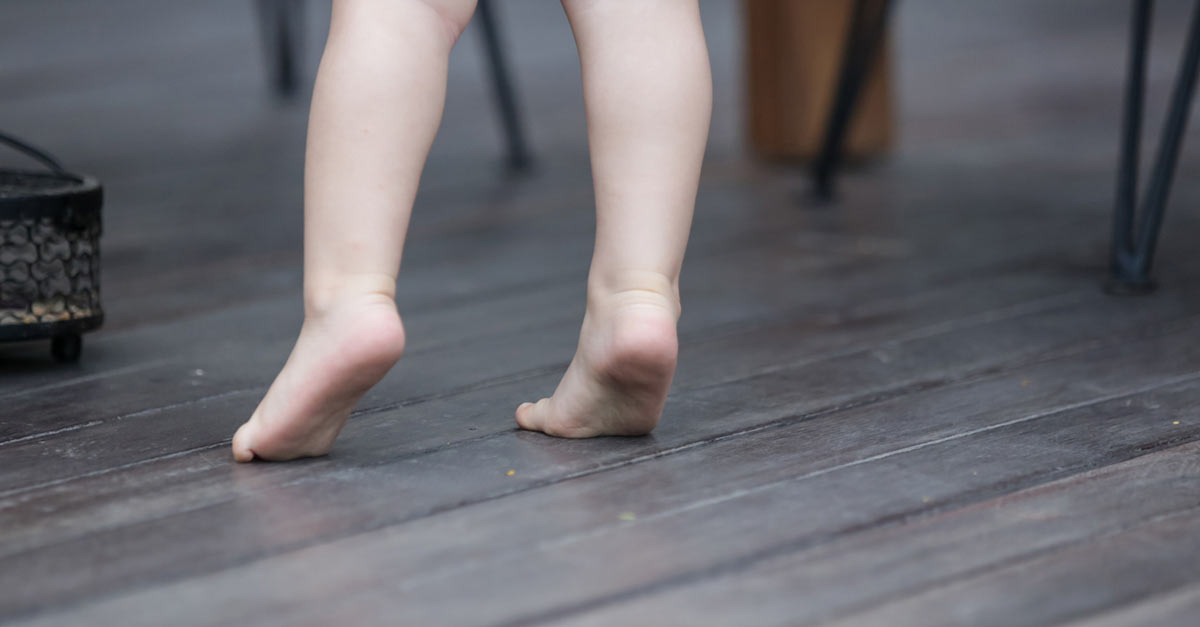Cerebral palsy toe walking: What causes it, and can it be treated?

Toe walking is very common in children who are just learning to walk. Sometimes, though, it can be a sign of a medical condition like cerebral palsy (CP). Learn more about toe walking in children with CP, including what causes it as well as potential treatment options.
What is toe walking?
Toe walking is when a child walks on the balls of their feet, with no contact between their heels and the ground. This can happen when they are barefoot or wearing shoes, and it looks similar to standing on your tiptoes.
It’s fairly common for children just beginning to walk to use their tiptoes as they learn how to balance their body weight.
The majority of toe walking is idiopathic (meaning the exact cause isn’t known). Most children outgrow toe walking after the age of 2 and start to walk with a normal heel-to-toe pattern.
Many older children who continue to walk on their tiptoes simply do so out of habit. However, toe walking can sometimes be caused by cerebral palsy or another underlying condition that affects a child’s muscles and body movements.
If your child is 2 or older and walks on their toes most of the time, contact us today to learn more. Our team can help determine if your child may have cerebral palsy.
What causes toe walking in children with cerebral palsy?
The most common cause of toe walking in those with cerebral palsy is spasticity.
Spasticity refers to involuntary muscle contractions caused by damage to the brain. Spasticity can pull a child’s limbs in abnormal positions and cause stiff movements.
According to the Centers for Disease Control and Prevention (CDC), most (about 75%-85%) of children who’ve been diagnosed with CP have spastic CP.
Children with spastic CP have stiff muscles, and their movements can be awkward as a result.
A specific type of CP called spastic diplegia that mostly affects the legs is a primary cause of toe walking in children with CP. Spastic diplegia can cause a child’s calf muscles to continuously contract and pull on their heels, keeping them from touching the ground.
Over time, the leg muscles can get used to being in this shortened position, which makes it harder to reverse toe walking in a child with CP. Identifying and treating toe walking early on can help minimize any discomfort and possibly correct this pattern before it becomes a habit.
If your child is aged 2 or older and walks on their tiptoes at least half the time, it’s important to have them evaluated by a doctor.
Does toe walking have any risks?
Yes. When a child walks on their toes for a long period of time, the bones and ligaments in the lower back, knees, and hips are tensed unnaturally.
This can lead to improper bone growth and/or ligament overstretching, which can put children with CP at risk for injury and joint discomfort as they get older.
Other possible complications associated with toe walking include:
- Chronic pain caused by muscle tightness and excess pressure on the ankles
- Difficulty riding a bike, squatting, or climbing stairs
- Frequent falls due to poor balance and stability
- Inability to walk flat-footed
- Poor posture
- Problems wearing shoes
- Social stigma from walking differently than their peers
- Soreness after walking
- Stiffness, tightening, and pain in their Achilles tendon (the band of tissue that connects the calf muscles to the heel bone)
Catching toe walking early on can help reduce some of the physical risks listed above.
Toe walking is usually easily observed by parents, but it can be officially diagnosed through a physical exam.
During the exam, the doctor will observe the way your child walks (their gait) as well as their range of motion and muscle tone.
If the doctor suspects your child has cerebral palsy or another underlying condition, they may recommend a neurological exam or tests to check for developmental delays.
What treatment options can help with toe walking?
Treatment for toe walking in children with CP depends on how old the child is and whether they’re physically able to walk flat on their feet.
Most podiatrists (doctors that treat foot problems) will start conservatively with treatment. Surgery is usually recommended only as a last resort when there is an issue with the Achilles tendon or calf muscles.
Toe-walking treatments might include:
- Physical therapy: Physical therapy sessions to stretch and strengthen the muscles can help a child improve their gait.
- Bracing: A custom plastic brace called an ankle-foot orthosis (AFO) can help encourage a flat foot when walking. It can be worn during the day or at night to stretch tight calf muscles and tendons.
- Serial casting: Short leg casts applied for 1-2 week intervals can stretch tight muscles over time and improve the position of the foot and ankle.
- Botox® injections: Children over the age of 2 can be given an injection of botulinum A toxin (Botox) to temporarily relax their calf muscles. This helps the muscles stretch more easily during serial casting or bracing.
- Achilles tendon lengthening: If a child’s calf muscles and Achilles tendons are so tight that walking flat-footed is not possible, surgery can be performed to lengthen the tight Achilles tendon. This can increase the range of motion and function of the child’s foot and ankle.
Your child’s doctor or physical therapist may also recommend specific stretches that can be done at home to ease muscle tension.
We’re also here to help. Chat with one of our registered nurse advocates to see if there are any resources that may help with your child’s treatment.
Learn more about foot problems in children with cerebral palsy
Toe walking and other foot issues in children with cerebral palsy can be better managed with early intervention and treatment. Having an orthopedic specialist on your child’s medical team is especially important to help prevent any negative effects of long-term toe walking.
To learn more about mobility and support options that may be available to your child, download our free Cerebral Palsy Guide.

